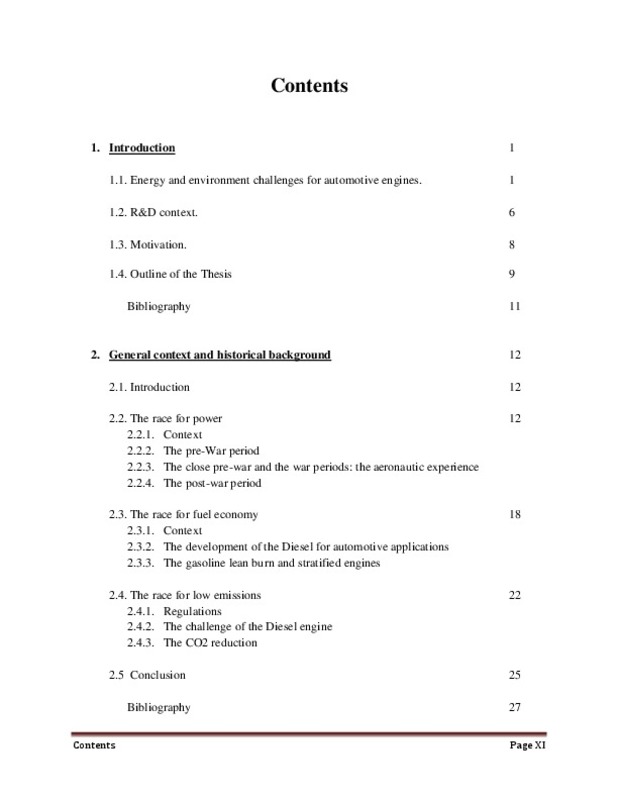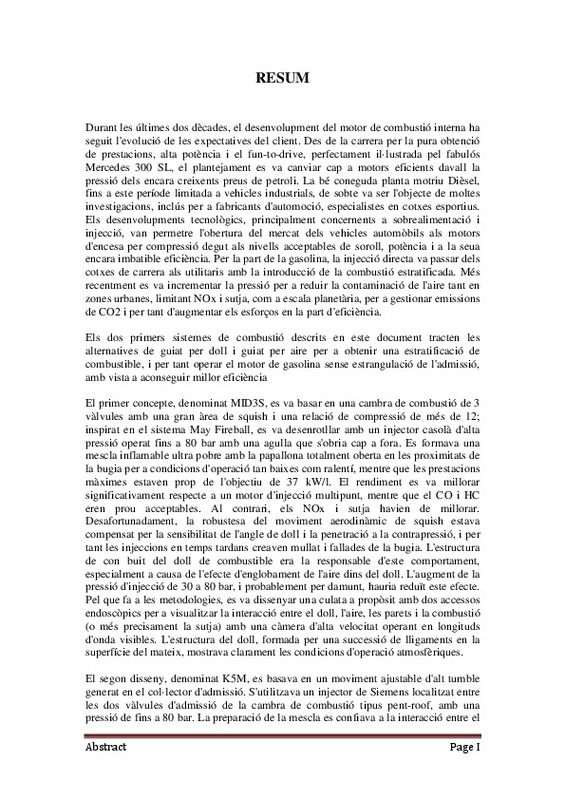- RiuNet repositorio UPV
- :
- Investigación
- :
- Tesis doctorales
- :
- Ver ítem
JavaScript is disabled for your browser. Some features of this site may not work without it.
Buscar en RiuNet
Listar
Mi cuenta
Estadísticas
Ayuda RiuNet
Admin. UPV
INFLUENCE OF THE MIXTURE PREPARATION ON THE COMBUSTION IN DIRECT INJECTION ENGINES
Mostrar el registro sencillo del ítem
Ficheros en el ítem
| dc.contributor.advisor | Payri González, Francisco
|
es_ES |
| dc.contributor.author | GASTALDI, PATRICK
|
es_ES |
| dc.date.accessioned | 2015-03-31T06:02:26Z | |
| dc.date.available | 2015-03-31T06:02:26Z | |
| dc.date.created | 2015-01-16 | es_ES |
| dc.date.issued | 2015-03-31 | es_ES |
| dc.identifier.uri | http://hdl.handle.net/10251/48534 | |
| dc.description.abstract | During the last two centuries, the development of the internal combustion engine has followed the evolution of the customer expectations. From the race for pure performances, high power, and fun to drive, perfectly well illustrated by the fabulous Mercedes 300 SL, the focus moved towards fuel efficient engines under the pressure of the still increasing oil prices. The well-known Diesel powertrain, up to this period limited to industrial vehicles, suddenly became the object of many researches, even for automotive manufacturers, specialists for sport cars. Technologic developments, mainly concerning turbocharging and injection, allowed the opening of the passenger cars market to CI engines due to acceptable noise, power and still unreachable efficiency. On the gasoline side, direct injection moved from racing to economic cars by the introduction of the stratified combustion. More recently, the pressure rose for dramatically reducing the air pollution, both in urban areas, by limiting NOx and soot, but also, at the scale of the earth, for managing CO2 rejections and thereby enlarging the efforts on efficiency. The two first combustion systems described in this document are concerning spray guided and air guided design alternatives to obtain a fuel stratification, and thereby operate the gasoline engine without throttling the air intake, aiming at a better fuel efficiency. The first concept, called MID3S, was based on a 3 valve combustion chamber with a large squish area and a high compression ratio over 12; inspired from the May Fireball system, it was developed with a house made high pressure injector operating up to 80 bars with an outwardly opening needle. An ultra-lean flame-able mixture was formed at WOT in the vicinity of the spark plug for different operating points as low as idle, while the maximum performances were quite close to the targeted 37 kW/l. The efficiency was significantly improved compared to a similar MPI engine while CO and HC were quite acceptable. On the contrary, NOx and soot would have to be improved. The robustness of the squish aerodynamic motion was unfortunately balanced by the sensitivity of spray angle and penetration versus the back pressure and thereby late injection timings, creating plug wetting and fouling. The hollow cone structure of the fuel plume was clearly responsible of this behavior, especially because of the effect of the air entrainment inside the spray. An increase of the injection pressure from 30 to 80 bar, and probably upper, would probably reduce this effect. Concerning methodologies, a dedicated cylinder head was designed with two endoscope locations in order to visualize the interaction between spray, air, walls and combustion –or more precisely soot- with a high speed camera operating within visible wavelengths. The spray structure, formed by a succession of ligaments at the surface of the plume, was clearly emphasized in atmospheric conditions. The second design, called K5M, was based on an adjustable high tumble motion generated in the intake port. A swirl injector provided by Siemens and located between the two intake valves of the pent roof chamber, was operated until 80 bar. Mixture preparation was relying on the interaction between the air motion and the spray, the tumble velocity deviating fuel droplets towards the spark plug situated at the center of the chamber. 3D CFD simulation, PIV and LIF visualization techniques on an optical single cylinder engine were used in parallel in order to understand the spatial evolution of the equivalence ratio during the cycle and the ability to operate the engine at WOT, even at part load. At low BMEP and speed, the natural reduction of the tumble intensity might have been followed by a significant reduction of the injection pressure in order to secure an accurate balance between the two momentum energies; unfortunately, both high cycle to cycle aerodynamic fluctuations and a poor spray atomization at 30 bar didn’t allow to achieve an acceptable ignition stability at low loads due to a too lean mixture in the plug vicinity. Protruded electrodes could have been a solution to the problem but their reliable use in serial life was not secured. On the contrary, mid load performances were globally adequate. The third concept is concerning Diesel combustion aiming at very low NOx and soot emissions by using an innovative injection system. The basic idea relies on the use of a quite homogeneous combustion at low load –called Mild HCCI- and on a diffusion controlled one at higher loads. Based on two injections close one of the other in the vicinity of TDC, the Mild HCCI allows to moderate the combustion noise inherent to the premixed burning phase as the fuel injected during the second injection cools down the first combustion; the advantages of very low NOx and soot emissions until around 8 bar BMEP are meanwhile maintained. Above this value, the noise level becomes unacceptable for automotive applications and the come back to a conventional diffusive combustion becomes mandatory. Based on early academic investigations pointing out the positive effect of small nozzle holes associated to high injection pressures in terms of soot via a significant difference between the lift-off length and the liquid penetration length, an innovative injection system was adapted to a conventional combustion chamber. The first conclusion was concerning a significant improvement of the NOx/soot tradeoff at mid and high loads with quite usual EGR rates. This advantage was due to a much better fuel atomization linked to both small holes and high pressures. The second conclusion was related to the possibility to achieve a “0 soot/ 0 NOx” combustion at high loads while very much increasing EGR and air mass flows. In this case, a Lifted Flame Diffusion Controlled combustion was generated, confirming on a scale 1 engine the results obtained in academic conditions. Nevertheless, the use of 3D simulation allowed to demonstrate that mixture preparation was only one part of the result; the location of the different stages of the combustion in a Kamimoto diagram, much away from the NOx and soot peninsula, highlighted the impact of the LTC (Low Temperature Combustion) thermodynamics. Unfortunately, despite these good results, industrially available EGR and air systems are not able to provide the necessary mass flows. Concerning tools, the development steps were followed by intensive spray visualizations for both the liquid and the vapor phases, in conditions closer and closer to the actual engine. These measurements allowed to precisely evaluate the impact of the diameter size, the rail pressure and the oxygen content on the difference between lift-off and liquid lengths. Finally, the importance of coupling investigation tools like visualization and 3D simulation in conditions as close as possible to the actual engine in terms of temperature, pressure and timing –eg the ability to record a complete mixture and combustion cycle- has been emphasized for both future SI and Diesel engines. In particular, the forecasted increase of the rail pressures will lead to re-optimize the different available spray models and eventually to re-adapt them in terms of physical phenomena because of the great variations of the spray velocity and of the Weber number. The presence of cavitation in the nozzle holes will also have to be taken into account as it has a key role versus coking. In conclusion, it is quite clear that the development of stratified gasoline and low emissions Diesel engines will more and more rely on the mixture preparation and on its association with low gas temperatures. | en_EN |
| dc.language | Inglés | es_ES |
| dc.publisher | Universitat Politècnica de València | es_ES |
| dc.rights | Reserva de todos los derechos | es_ES |
| dc.subject | Mixture preparation | es_ES |
| dc.subject | Combustion | es_ES |
| dc.subject | Engine | es_ES |
| dc.subject | Pollutant emissions | es_ES |
| dc.subject.classification | MAQUINAS Y MOTORES TERMICOS | es_ES |
| dc.title | INFLUENCE OF THE MIXTURE PREPARATION ON THE COMBUSTION IN DIRECT INJECTION ENGINES | es_ES |
| dc.type | Tesis doctoral | es_ES |
| dc.identifier.doi | 10.4995/Thesis/10251/48534 | es_ES |
| dc.rights.accessRights | Abierto | es_ES |
| dc.contributor.affiliation | Universitat Politècnica de València. Departamento de Máquinas y Motores Térmicos - Departament de Màquines i Motors Tèrmics | es_ES |
| dc.description.bibliographicCitation | Gastaldi, P. (2015). INFLUENCE OF THE MIXTURE PREPARATION ON THE COMBUSTION IN DIRECT INJECTION ENGINES [Tesis doctoral]. Universitat Politècnica de València. https://doi.org/10.4995/Thesis/10251/48534 | es_ES |
| dc.description.accrualMethod | TESIS | es_ES |
| dc.type.version | info:eu-repo/semantics/acceptedVersion | es_ES |
| dc.relation.pasarela | TESIS\9103 | es_ES |
Este ítem aparece en la(s) siguiente(s) colección(ones)
-
Tesis doctorales [5389]












